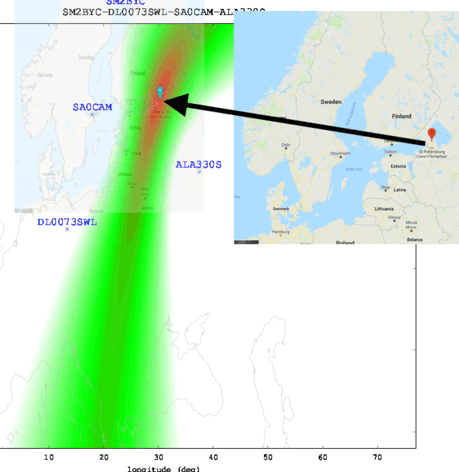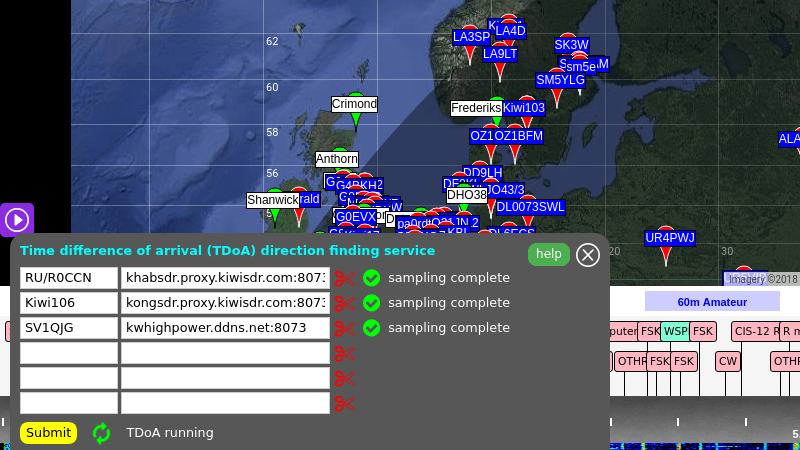Radio direction finding is one of those things that most Hackaday readers are likely to be familiar with at least on a conceptual level, but probably without much first-hand experience. After all it’s not everyday that you need to track down a rogue signal, let alone have access to the infrastructure necessary to triangulate its position. But thanks to the wonders of the Internet, at least the latter excuse is now a bit less valid.

The RTL-SDR Blog has run a very interesting article wherein they describe how the global network of Internet-connected KiwiSDR radios can be used for worldwide radio direction finding. If you’ve got a target in mind, and the time to fiddle around with the web-based SDR user interface, you now have access to the kind of technology that’s usually reserved for world superpowers. Indeed, the blog post claims this is the first time such capability has been put in the hands of the unwashed masses. Let’s try not to mess this up.
To start with, you should have a rough idea of where the signal is originating from. It doesn’t have to be exact, but you want to at least know which country to look in. Then you pick one of the nearby public KiwiSDR stations and tune the frequency you’re after. Repeat the process for a few more stations. In theory the more stations you have the better, but technically three should be enough to get you pretty close.
With your receiving stations selected, the system will then start Time Difference of Arrival (TDoA) sampling. This technique compares the time the signal arrives at each station in relation to the KiwiSDR’s GPS synchronized clock. With enough of this data from multiple stations, it can estimate the origin of the signal based on how long it takes to reach different parts of the globe.
It’s not perfect, but it’s pretty impressive for a community run project. The blog post goes on to give examples of both known and unknown signals they were able to triangulate with surprising accuracy: from the US Navy’s VLF submarine transmitter in Seattle, Washington to the mysterious “Buzzer” number station hidden somewhere in Russia.
We’ve covered small-scale triangulation using Wi-Fi, and even a project that aimed to use drones to home in on rescue beacons, but the scale of the KiwiSDR TDoA system is really on a whole new level. Use it wisely.
















Dandy for SDR, but RDF is already incorporated in “Speclab” software by just connecting two receivers to sound input. Speclab is awesome!
“Spectrum Lab runs under Windows 98, 2000, ME, XP (home and professional), Linux/WINE, but obviously not under Windows Vista. The reason why it doesn’t work under “Vista” is unknown.“
http://www.qsl.net/dl4yhf/spectra1.html
Do you know if there is a more recent erosion of this somewhere
“Version” ????
I liked erosion better…
The pace of releases is on a geological time scale.
The RDF function in Speclab calculates bearing from one location using differences from two inputs (usually antennas like loops mounted at right angles).
The time difference of arrival (TDoA) algorithm implemented here uses GPS time-stamped IQ samples from up to six crowd sourced KiwiSDRs that are then post-processed with autocorrelation techniques. The TDoA implementor’s blog (not me) makes interesting reading: http://hcab14.blogspot.com
Now all I need is a long enough audio cable to hook up receivers from all over the world to my computer…
I made recordings of the sounds hear layered onto natural sounds, or coming from thin air, with Spectrum Lab as well as an RTL-SDR. Either of the KiwiSDR’s would be even better.
Would be nice to find a “complete history and copies of all the versions” site. There was a university version I liked best and am not recalling who’s version… maybe 2.71b from ??? University.
I’m not aware of Spectrum Lab being networked and having a synchronized oscillator though. I think there are the capabilities, though are there systems in operation with an interface to control via an online http or https website?
Replace triangulation with trilateration.
Triangulation uses directional antenna. That’s how ARDF (the sport) works.
Trilateration uses omnidirectional antenna and measures time difference (how GPS works).
i want in
We should try doing the same but with a synchronization pulse added into the mix: while gnss time is all fine, a pulse sent from a place near the unknown beacon could help compensate the time resolution of the gnss as well as atmosheric propagation delay found locally
Any idea?
Good, this should help track down where those mysterious numbers stations are located.
Awesome!
A use for the $13 SDR?
https://hackaday.com/2018/05/30/cheap-stuff-to-hack-a-router-with-an-sdr-for-13/
Might be able to coordinate with all the RTL-SDR online site operations and do the same. The issue is going to be updating the oscillators to be synchronized to… say a GPS oscillator or maybe somehow get a NIST Atomic clock signal distributed.
I remember hearing a story years ago of a professor at the university of Washington who built a passive radar system, it could track airplanes by correlating scattered signals from commercial FM radio and television stations across multiple receivers.
It turns out these sorts of radars are quite useful for detecting stealth aircraft that absorb conventional microwave radar bands and scatter incoming radio waves away from the transmitter.
For a time there was a live feed available online but some guys in black suits showed up at his office to politely request that he add a time delay to the data. I’m not sure if the public feed was taken down then or shortly after 9/11 but it doesn’t appear to be available anymore.